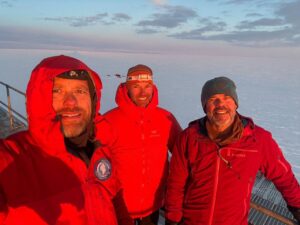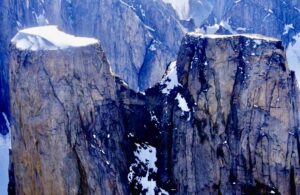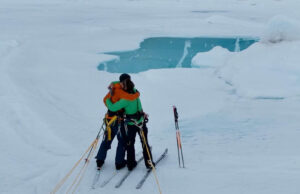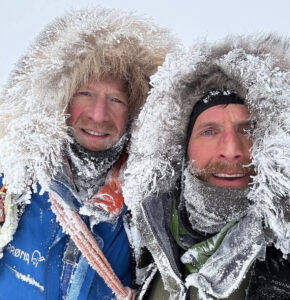What is usually called the Greely Expedition was supposed to be a scientific endeavor with some exploration thrown in. It was the northernmost of six projects across the circumpolar Arctic for the first International Polar Year of 1882-3. No one remembers the other five, but the Greely expedition became legendary because 19 of the 25 men died. What is most astonishing is that six survived.
Greely and most of his men came from the U.S. Army’s Signal Corps. Their job had been to string telegraph lines across the West. None had experience in the Arctic, except a non-military man, their physician Octave Pavy, who had once visited Greenland.
In 1881, they sailed to a place they called Fort Conger, near the northeast corner of Ellesmere Island. It was a hard spot to reach, because of thick sea ice, but a British expedition six years earlier had managed. The ship that brought the Greely party also encountered a good ice year.
Unlike almost every other polar expedition, the ship did not stay with Greely. It deposited the men and their supplies and sailed back home. It was to return with more supplies and a change of personnel the following summer.
Greely’s men built a large house, in which they all lived. Although later explorer Robert Peary used the wood to build three smaller, more efficient shelters, the outline of the house and many artifacts remain today.


The outline of the Greely house. Peary’s smaller huts are in the background. Photo: Jerry Kobalenko

The raised deck marks the kitchen area. Also visible, a clay stovepipe. Pieces of old sea ice float in the harbor. Photo: Jerry Kobalenko

Greely’s stove. Photo: Jerry Kobalenko
They did the whole gamut of nineteenth-century science: meteorology, magnetism, biology. Although they did good work, it was not a happy crew. Greely was self-disciplined but too high-strung and micromanaging to command men in such a remote location. He interpreted grumbling as marginal mutiny and imposed penalties and restrictions.
Nevertheless, during the travel season of spring 1882, a small party of men forged north and managed to reach a mile further north than the earlier British. No country had ever reached the North Pole, but this gave the honor of Farthest North to the United States for the next dozen years.

To pass the time, Greely’s men built cairns on nearby hilltops. Here, they even carried a barrel with them, weighing it down with sand before setting it in place. Photo: Jerry Kobalenko
In the summer of 1882, the resupply ship Proteus wasn’t able to reach them because of thick ice. It turned out that this area is almost always blocked by heavy pack ice flowing down from the Arctic Ocean. They, and the British before them, had been astonishingly lucky to get there in the first place. Even today, in an era of much stronger ships and thinner ice because of climate change, no cruise ship dares attempt to reach Fort Conger. One tried once; it became stuck and had to be freed by a nuclear icebreaker.
The supply ship’s failure to appear was disheartening to some of Greely’s men, who were looking forward to being relieved, but it was not dire. They had plenty of food with them for another couple of years.

Greely’s crimped, meticulous journal, which he kept during his explorations inland. Photo: Jerry Kobalenko/Library of Congress
But when after another entire year, the relief ship didn’t show up by August 1883, they faced a crisis. They still had lots of supplies; but Greely’s original orders stated that they should abandon Fort Conger and work their way south to meet the Proteus, presumably lying just past the pack ice.
Most of the men thought that leaving their station was suicide. But Greely insisted that they follow orders, and so leave they did.
Little did they know that not only couldn’t the Proteus reach them, it was at the bottom of the ocean. About 300km south, the irresistible ice had trapped and crushed the wooden vessel. The men on the ship reached Greenland in their lifeboats and returned home safely. But the Proteus and almost all its supplies lay 400m down at the bottom of northern Baffin Bay.
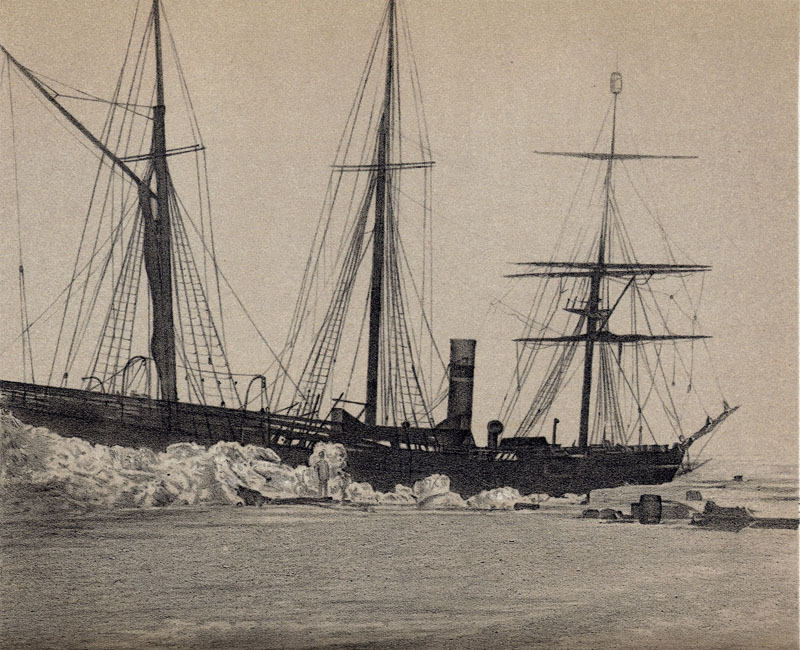
The Proteus, trapped in the ice. It remains North America’s northernmost sunken ship.
Covering the 300km from Fort Conger south over shifting sea ice was a two-month ordeal for Greely and his men. They had three small boats, but often they had to drag these burly crafts over ice floes or wait days or weeks until the ice released them so they could proceed another kilometre or two.
This was a low point for Greely, who seemed depressed and withdrawn. More natural leaders, such as David Brainard and George Rice, stepped up to ensure progress. Other figures, such as William Cross, a habitual drunkard, and Dr. Octave Pavy, a schemer who hated Greely, were not much help.
At one point, some influential men, including Pavy and Rice, plotted to declare Greely insane. They would relieve him of his command and return to the security of Fort Conger. But the universally respected Brainard had to agree to this mutiny, and he would not. It fizzled out.
It was mid-October by the time they reached landfall halfway down Ellesmere Island. The sun had almost disappeared. Winter was upon them. The indefatigable George Rice, who never met a shit job that he wouldn’t volunteer for, went exploring. In a cairn note, he discovered the fate of the Proteus. The ship’s men had managed to leave them 40 days of food but that was it. Winter is eight months long at this latitude.
Greely and his men had started building winter shelters — low stone walls topped with their small boats — at a place called Eskimo Point (now Wade Point). When Rice brought back his information about the Proteus and the food cache, they moved a little further north, to Pim Island.

One of the original shelters at Eskimo/Wade Point, which they abandoned for Camp Clay, about 25km north. Photo: Jerry Kobalenko
Pim is a bleak hellhole exposed to the rough weather of the open ocean. Just 30km further, inside a fiord, was a comparative oasis. The hunting was so good there that a later expedition established a successful hunting camp. But Greely’s men couldn’t know this.
Instead, they built a quadrangle of stone walls on Pim Island, at a place they called Camp Clay. They draped their biggest boat over it, covered that with a tarpaulin, insulated it with snow, and settled down to try to survive the winter, somehow.

A shred of the tarpaulin still at Camp Clay. Photo: Jerry Kobalenko

Camp Clay, where Greely’s men lived for over seven months. Photo: Jerry Kobalenko
One of the intriguing things about the Greely expedition is how well the personalities of most of the 25 men come across. Unlike the Franklin expedition, where the men are largely a cipher, you learn — sometimes from their accounts, because many of them kept journals, sometimes from the accounts of others — how they handled this ordeal. Many became weaker, a few became stronger, and a couple went to the Dark Side. In some ways, all humanity is visible in the Greely expedition.
“The Greely expedition taught me everything about life, except how to deal with the opposite sex,” an arctic partner of mine once joked. He had fixated on the Greely expedition since reading a serialized account of it as a child.
Greely turned out to be a better wartime than peacetime commander. He largely vindicated himself at Camp Clay. He did his best to maintain discipline, as the men slowly deteriorated through starvation. Greely even tried to distract the men by putting on a lecture series, although such topics as The Grain Products of the United States were likely not rousing entertainment.

Two to a sleeping bag, with temperatures in the shelter hovering around freezing, the 25 men tried to survive on a pound of food a day, then a few ounces a day, then next to nothing.

The matchsticks that Greely’s men used to light their stove. Photo: Jerry Kobalenko
Most difficult for Greely was handling the tension of those stressful months. Some men still despised him because of his behavior at Fort Conger and could not forgive him. One man, Elison, frostbit his fingers so badly that Dr. Pavy had to amputate them all. They fed him by hand and even gave him extra rations.
They kept all their food in a separate little storehouse outside the main shelter. Every day, Sergeant Brainard issued each man his ration, accurate to a fraction of an ounce. Although this storehouse was locked in some fashion, its security was easy to penetrate. In the darkness of the High Arctic winter, food theft occurred.
After just two and a half months, William Cross, the alcoholic, became the first to die. They buried him in a morose ceremony on a gravel bench above camp that they called Cemetery Ridge. They scraped a shallow depression in the frozen ground and covered the body as best they could with a little gravel. Cross was just the first of many to have his remains moved up there.
Few animals passed their barren camp. They shot a few foxes, but arctic foxes are tiny. Divided into a couple of dozen rations, each fox was less than a mouthful. Once, they killed a polar bear. This was a more serious catch, but among so many men, even that just extended their suffering by a couple more weeks.
Later, because their island abutted the open water of the North Water Polynya, they tried netting what they called shrimps — tiny copepods — in some nearby shallows. This was more successful, and for a period, each man was able to eat almost a pound of these oily creatures a day. They caused digestive issues, possibly because of the copepods’ high-fat content.
There is a limit to what percentage of fat the body can handle. One modern polar expedition tried living mainly on fat to save weight; fat has twice the calories of the equivalent weight of carbohydrates or protein. That modern expedition also suffered intestinal issues. Nevertheless, although a despised food item, the copepods prolonged life and saved the handful of survivors.

Copepods from the shallows near Camp Clay. Photo: Jerry Kobalenko

They netted copepods in the little cove closest to the bottom of the photo above. Photo: Jerry Kobalenko
Once, in desperation, Rice — the tireless volunteer — and another man tried to walk across the ice to Greenland, where they would likely find Inuit to save the rest of the party. Their attempt failed because of open water. They didn’t realize that the polynya, this area of permanently open water, typically ends a little further north. Had they detoured about 30km further north, they likely would have managed to cross. Again, they could not have known this.
After that failure, Rice and a partner tried to trek 50km south, to pick up a cache of food at Cape Isabella, left by the earlier British expedition. They succeeded, but Rice, burned out by too much work, died in his companion’s arms on the way back. His companion could not drag the meat himself and left it on the ice with Rice’s body.


As the months wore on, men died one by one. More and more, Cemetery Ridge lived up to its name. The quasi-cheery lectures about wheat had long ended. The talk was all about food — the best things they’d eaten in the past, fantasy menus they’d eat in the future if they lived. This fantasy was all that occupied some men’s thoughts. Even Brainard gave in to it at times. One page of his journal chronicles not only his own food obsessions but the favorite dishes of other men.

Brainard’s journal, with lists of fantasy dishes. From: Stefansson Collection, Dartmouth College
Problems with food theft continued, and there was another issue as well, not known at the time: Some men were cutting pieces of meat from the dead bodies of their comrades.
It was generally known that Dr. Pavy was stealing some of his patient Elison’s extra rations as he fed the fingerless man. But the most brazen thief of all was Charles Henry. Already big man when he went north, the strapping Henry had put on 10kg at Fort Conger.
Greely warned him repeatedly not to steal food, but Henry felt — not without justification — that he would likely be the last survivor and could craft his own story when rescuers finally came. He ignored Greely’s warnings.
Finally, in early June, Greely wrote a secret note to three of the stronger men remaining. It ordered them to execute Henry for his repeated thefts. Two of the men had live rounds, one had blanks, so no one could be sure who was responsible. The three converged on Henry outside. He rushed them, but they shot and killed him.

Greely’s handwritten note, ordering the execution of Charles Henry for stealing food. From: Stefansson Collection, Dartmouth College. Photo: Jerry Kobalenko
By this time, most of the men had died and the few survivors clung to life by a thread. They didn’t have the strength to row the 50km to Greenland, so they burned the wood for fuel. Flooding within the stone walls from snowmelt prompted them to move to a dry bench halfway between their camp and Cemetery Ridge. Here, they erected a tent and waited for death.

Camp Clay in summer. The stone walls are almost invisible against the similarly colored foreground and background. By this time of year, Greely’s had moved to a tent site halfway up the ridge to escape the flooding. Photo: Jerry Kobalenko
Although she isn’t as well-known in the annals of arctic history as Lady Jane Franklin, Greely’s wife Henrietta had never stopped lobbying the politicians in Washington to launch a rescue operation as soon as possible. Her persistence succeeded. Two small ships, the Thetis and the Bear, made it to Greely’s latitude by the third week of June — incredibly early in the season. The men from one ship, inspecting nearby points of land for cairns and messages, saw one of the survivors, waving a tattered pair of underwear at the end of a pole.

Seven men were still alive. All were on the edge of death — hours, at most a day or two. The rescue team also brought the bodies of the dead from Cemetery Ridge aboard the ship. This is when they noticed the chunks of flesh carved out from some of them. The shocking revelation of cannibalism made the front page of The New York Times when they returned home.
One of the seven survivors did not make it back. Elison, who had lost all his fingers to frostbite, had survived till the very end, thanks to the extra rations that all the men agreed that he merited for his suffering. In the last weeks, they had tied a spoon to the stump of his hands so he could feed himself (on what?) if everyone else died first.
But once on the rescue ship, fed properly and in a warm cabin, Elison’s circulation increased. Gangrene set in, and he perished three days after rescue.

The six survivors. Standing, ‘Shorty’ Frederick, William Connell, Francis Long. Seated, Henry Biederbick, Adolphus Greely, David Brainard.
So in the end, six made it back, including Greely and Brainard. Greely’s survival is surprising, given how skinny he always was. Beanpoles are normally the first to go during long starvation ordeals.
Greely and Brainard stayed in the army and became generals. Every year on June 22, the anniversary of their rescue, the two of them got together to eat one of the menus that they and the other men fantasized about at Camp Clay.
When Greely died in 1935 at the age of 91, Brainard became the last survivor of the expedition. “To be the last man,” Brainard admitted, “is a lonesome job.”

